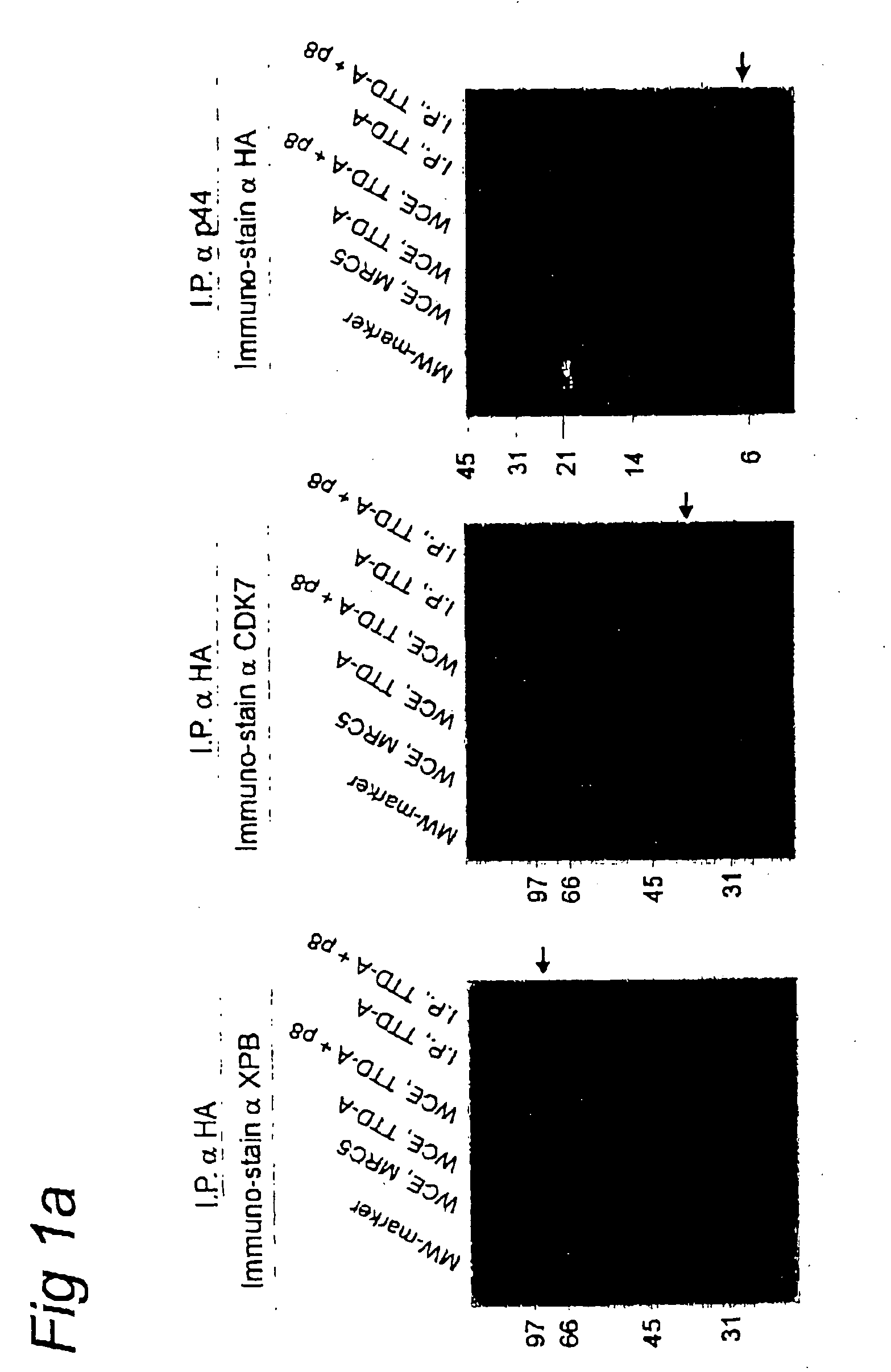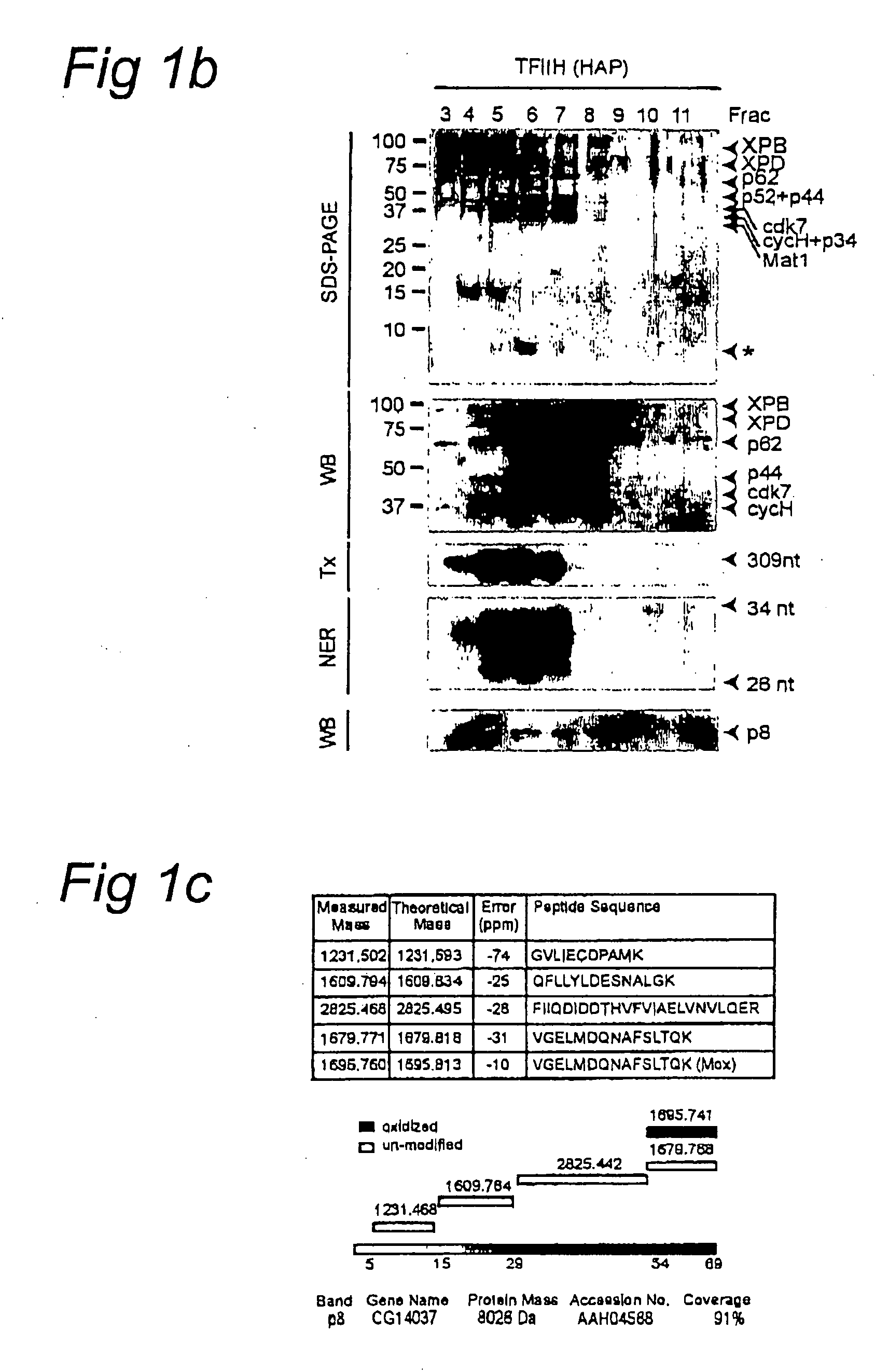Novel TFIIH subunit
a subunit and gene technology, applied in the field of cell biology and medicine, can solve problems such as premature or enhanced ageing symptoms or phenotypes
- Summary
- Abstract
- Description
- Claims
- Application Information
AI Technical Summary
Benefits of technology
Problems solved by technology
Method used
Image
Examples
example 1
Cloning of hTFB5 / TTDA
[0063] We cloned the human TFB5 cDNA from primary fibroblasts by virtue of its homology with yeast TFB5 using conventional techniques known in the art. An HA-tagged version of hTFB5 (p8-HA) was constructed via conventional molecular cloning methods (Maniatis et al, supra) and expressed in TTD-A fibroblasts and subsequently used for immuno-precipitations with anti-HA (FIG. 1a). Both the XPB core TFIIH and the associated CAK component (CDK7) were co-precipitated with p8-HA, in contrast to replication / repair factor RPA1 (data not shown). Conversely, anti-p44 (another core-TFIIH component) co-precipitated p8-HA. We conclude that, analogous to yeast, this small polypeptide is associated with TFIIH in mammalian cells.
[0064] We further analyzed the association of p8 with TFIIH using—purified TFIIH from HeLa cells (Gerard, M. et al., J. Biol. Chem. 266, 20940-20945, 1991). Silver-staining revealed that a protein-band of ˜8 kDa co-purified with the other TFIIH subunits...
example 2
TTDA Diagnosis of Subjects
[0066] To verify that hTFB5 is implicated in TTD-A we analyzed genomic DNA of three unrelated TTD-A cases (Table 1). All three TTD-A patients showed an inactivating, although distinct, mutation within the hTFB5 gene (FIG. 2b). Patient TTD99RO carries a homozygous C→T transition at codon 56, converting CGA (arginine) into a TGA stop codon, truncating the protein by 23%. Siblings TTD13PV and TTD14PV harbor (homozygously) a mutation in the start codon, converting ATG to ACG. This mutation will result in either a complete loss of protein synthesis or the production of an N-terminal truncated polypeptide (lacking the first and most conserved 15 amino acids (21%)), when a downstream AUG at codon 16 is used. Since only one allele was detected, both mutations can be considered functionally homozygous.
[0067] Finally, patient TTD1BR appeared a compound heterozygote: one allele being identical to TTD99RO and the other carrying a T→C transition at codon 21, convertin...
example 3
TTDA Involved in NER Repair, an Assay for TTDA Activity
[0069] To further explore the role of TTDA in NER we generated TTD1BR-SV cells stably expressing HA-tagged TTDA. Exposure of the TTDA-HA expressing cells to UV-C light (FIG. 3a) clearly showed that the cells exhibit a TV-sensitivity level comparable to NER-proficient cells assayed in parallel. Using an assay in which UV-damage is locally inflicted in cell nuclei by irradiation through a filter that contains (5 μm) pores, we demonstrated previously that TFIIH components transiently accumulate at these sites (Mone, M. J. et al., EMBO Rep. 2, 1013-10117, 2001, Volker, M. et al., Mol. Cell 8, 213-224, 2001 and Hoogstraten, D. et al, Mol. Cel. 10, 1163-1174, 2002). We applied the same procedure on TTDA-HA expressing cells to test participation of TTDA in the NER reaction in vivo. At local damaged sites, marked by the accumulation of endogenous XPB, TTDA-HA also accumulated (FIG. 3b). This indicates that TTDA participates in the NER ...
PUM
| Property | Measurement | Unit |
|---|---|---|
| Fraction | aaaaa | aaaaa |
| Fraction | aaaaa | aaaaa |
| Atomic weight | aaaaa | aaaaa |
Abstract
Description
Claims
Application Information
 Login to View More
Login to View More - R&D
- Intellectual Property
- Life Sciences
- Materials
- Tech Scout
- Unparalleled Data Quality
- Higher Quality Content
- 60% Fewer Hallucinations
Browse by: Latest US Patents, China's latest patents, Technical Efficacy Thesaurus, Application Domain, Technology Topic, Popular Technical Reports.
© 2025 PatSnap. All rights reserved.Legal|Privacy policy|Modern Slavery Act Transparency Statement|Sitemap|About US| Contact US: help@patsnap.com



